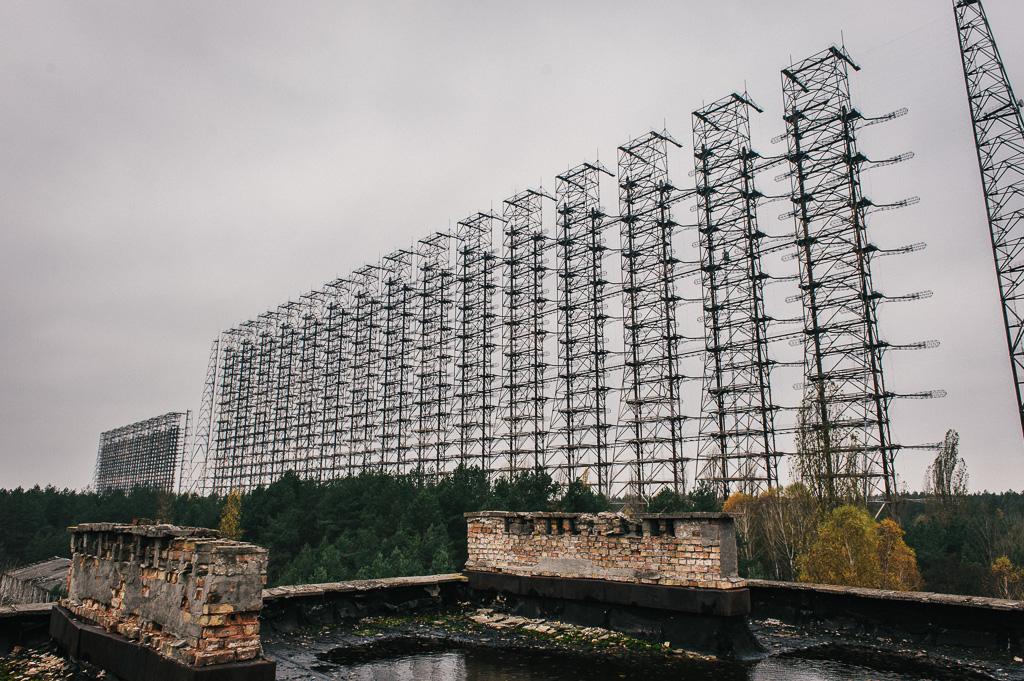| Rugby Radio |
In our program today, we present Part 3 in our mini-series on Abandoned Radio Stations, and this time we examine the story about four major shortwave stations; in Wales, Holland, Ukraine and Australia. Let’s go to Wales first.
Back in the early part of World War 2 in the middle of the last century, hurried plans were developed for the construction of an important communication station as a back up for the larger and more important Rugby Radio. The huge wireless a station at Rugby was taken into service in 1925, and at the height of its massive capability, it contained more than 30 transmitters, mostly shortwave, though the superpower very low frequency longwave transmitter was capable of communicating with submarines almost anywhere. There were times also, when Rugby Radio carried a relay of BBC radio programming on shortwave for rebroadcast and for direct listening in overseas countries.
During the stressful years of World War 2, the British authorities determined to build a backup station for Rugby Radio in England and a location in a lonely area near Criggion, across the border in Wales, was chosen. The Criggion station also contained shortwave and longwave transmitters together with a massive aerial and counterpoise system that was attached to a nearby high hill.
The three tall towers installed at Criggion were originally slated for erection at the British navy communication station at Trincomalee Sri Lanka, but because of the high priority for Criggion they were diverted to the location in Wales. As we know, Trincomalee was subsequently taken over by Deutsche Welle for their Asian relay station, and it is now operated by SLBC, the Sri Lanka Broadcasting Corporation. There are times when this program, Wavescan, is on relay from SLBC Trincomalee.
Criggion Radio began service on shortwave in July 1942, and the station was declared redundant in 2003, due mainly to the availability of satellite communication. Useful electronic equipment was removed and installed elsewhere, and since then the station has lain vacant and abandoned.
Weeds abound everywhere, the interior of the main transmitter building has been trashed and broken, though it still stands strong and solid. A total of some 10 auxiliary buildings are in the same condition, and the BBC declares that the station has been abandoned and left to rot.
Over the other side of the North Sea in the country of Holland, there is another high profile radio station that has been closed and abandoned. Radio Netherlands Worldwide RNW began the usage in 1985 of its huge shortwave station at Flevo, on ground that had earlier been reclaimed from the sea.
At the height of its usefulness, RNW Flevo contained 1 transmitter at 100 kW and 4 at 500 kW, though the power of the 500 kW transmitters could be stepped down if desired. There were 17 curtain antennas for overseas coverage and 2 for local coverage in Europe.
Radio Netherlands Flevo was closed in 2007, and the usable electronic equipment, including the 5 shortwave transmitters, was all removed. These days, the transmitter building and all of the tall self supporting antenna towers remain on site, unused and abandoned. This massive shortwave station can still be seen on Google Earth, impressively sited in the midst of serenely cultivated farm lands.
Let’s go over to the Ukraine now, to the site of what was a woodpecker over the horizon radar station. It all still stands there, quite near to the disastrous and abandoned nuclear generation plant at Chernobyl.
It will be remembered that there was a catastrophic nuclear accident at Chernobyl in 1986 that destroyed a nuclear reactor from which radio active fallout spread out across Europe. This disastrous event is by far the worst nuclear accident in the history of the world.
Still standing nearby, though bereft and abandoned, is a massive radio station that defies imagination for its size; it was known as the Woodpecker. This radio station transmitted super-powered shortwave signals in the form of over the horizon radar transmissions, which caused a havoc of interference in the international shortwave broadcasting bands.
 |
| Duga 3 |
And for our fourth abandoned radio station in our program today, we visit down under to the continent of Australia. Lying close to the Pacific coast in North Queensland is the small town of Brandon, and just three miles north of Brandon at the intersection of three roads (Jack, Colevale and Gordon), lies an ABC mediumwave and shortwave broadcasting station.
The Brandon property in the flat sugar cane country was acquired in 1958 and the 50 kW mediumwave station 4QN (630 kHz) was transferred from Clevedon and rebuilt further south at Brandon. Then 31 years later (1989), two 10 kW STC transmitters from the closed shortwave station at Lyndhurst in Victoria were installed with 4QN at Brandon.
The original intention was that subsequently two shortwave transmitters at 100 kW would be co-installed at the Brandon radio station. However, instead a third 10 kW transmitter from Lyndhurst was installed at Brandon (1999), and a few more years (2006), all three STC transmitters were replaced by two 20 kW DRM RIZ transmitters from Croatia. However, 9 years later again (2015), the shortwave service from Brandon was abruptly and unceremoniously closed.
The Brandon radio station is owned and operated by Broadcast Australia and it is an unattended relay station that carries the programming from the government operated ABC, the Australian Broadcasting Corporation. The medium wave station 4QN is still on the air at this location to this day, but the shortwave transmitters lie silent, and the two curtain antennas stand unused. However, even though the shortwave facility has been abandoned and is no longer in use, yet the outward appearance of the facility seems to indicate that it is all still in good condition
(AWR-Wavescan/NWS 460)
photo/http://www.subbrit.org.uk/sb-sites/sites/r/rugby_radio/index.shtml